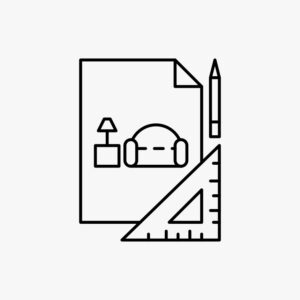Interior design is an art that aims to enhance our surroundings and make them more beautiful and functional. To achieve this goal, we, as design experts, follow a set of principles. In this article, we will discuss in greater detail some of the fundamental interior design principles, including balance, rhythm, harmony and unity, contrast, emphasis, proportion and scale, and details.
Principle 1: Balance
Balance is one of the most important principles to consider when designing spaces. It refers to the distribution of different elements in the space, such as furniture and accessories, in a balanced and harmonious way so that the elements have the same visual weight when looking at the room. To achieve this, we carefully analyze different pieces’ shapes, colors, and textures to achieve balance in the design.
There are three types of Balance: symmetrical, asymmetrical, and radial.

Symmetrical balance
Symmetry involves mirroring and matching each side of the design. For example, placing two chairs on either side of a table or repeating furniture pieces on both sides of the room.
Asymmetrical balance
Here, we balance lines, colors, shapes, and fabrics without precise pattern repetition. This type creates a more appealing look for the space than a symmetrical balance. For example, balancing the furniture in the living room by placing the sofa in the center and two chairs next to each other.
Radial balance
This is achieved when there is a central focal point with other elements around it. For example, a round dining table with chairs around it.
Principle 2: Rhythm
Rhythm is an important principle in interior design as it contributes to creating a sense of movement and activity in the space. Rhythm is achieved when patterns and elements are repeated regularly in the space. Rhythm can be fast-paced and dynamic or slow and soothing, depending on the desired feeling we want to convey in the design.

Principle 3: Harmony and Unity
Harmony and unity principles work together to bring all the different elements in the design together to form a cohesive unit. Harmony refers to achieving coherence and coordination between colors, patterns, and materials, while unity aims to make the space look as if it belongs to one cohesive unit rather than an inconsistent, random appearance.

Principle 4: Contrast
Contrast is an important element for adding vitality and diversity to interior design. Contrast is achieved by combining different elements that contrast in color, size, shape, and materials to give the space a lively appearance. For example, mixing modern furniture with traditional artwork or placing small items next to large ones.

Principle 5: Emphasis
The emphasis principle works to identify focal points in interior design. These points are the prominent details or elements that draw attention. Emphasis can be part of the decor, such as a striking art wall or a set of colorful cushions on the sofa.

Principle 6: Proportion and Scale
Proportion and scale are essential aspects of interior design, as they relate to the size and scale of elements in the space. This principle requires us to consider the size of the furniture, ceiling height, and room space to achieve visual balance and aesthetics.

Principle 7: Details
Finally, focusing on details is a vital principle to add personality and authenticity to interior design. Small details can enhance the overall appearance and add a unique touch to the space. By carefully selecting decorations, accessories, and fabrics, we showcase the owner’s personality and attention to detail.

In conclusion, understanding and applying various interior design principles can make your home more beautiful and suited to your taste and needs. When employing these principles wisely, you can create a distinctive and attractive interior space that reflects your personality and fulfills your daily needs. Enjoy a wonderful experience that suits your artistic and aesthetic taste in every detail of your home, and choose Compelis to share the journey with you.